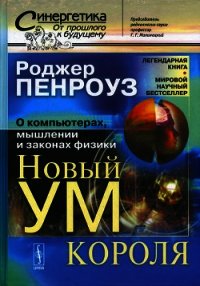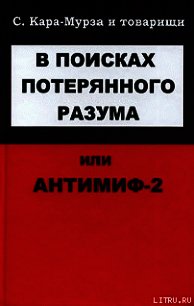Тени разума. В поисках науки о сознании - Пенроуз Роджер (книги онлайн полные версии бесплатно .TXT) 📗
[119] Feynman, R. P. (1982). Simulating physics with computers. Int. J. Theor. Phys., 21 (6/7), 467-488.
[120] Feynman, R.P. (1985). Quantum mechanical computers. Optics News, Feb., 11-20.
[121] Feynman, R.P. (1986). Quantum mechanical computers. Foundations of Physics, 16 (6), 507-531.
[122] Fodor, J. A. (1983). The modularity of mind. MIT Press, Cambridge, Massachusetts.
[123] Franks, N.P., Lieb, W.R. (1982). Molecular mechanics of general anaesthesia. Nature, 300, 487-493.
[124] Freedman, D. H. (1994). Brainmakers. Simon and Schuster, New York.
[125] Freedman, S.J., Clauser, J. F. (1972). Experimental test of local hidden-variable theories. В сб. Quantum theory and measurement (ed. J.A.Wheeler, W.H.Zurek). Princeton University Press, 1983; первоначально в Phys. Rev. Lett., 28, 938-941.6
[126] Frege, G. (1893). Grundgesetze der Arithmetik, begrif-fsschriftlich abelgeleitet, Vol. 1. H. Pohle, Jena.
[127] Frege, G. (1964). The basic laws of arithmetic, translated and edited with an introduction by Montgomery Firth. University of California Press, Berkeley.
[128] French, J. W. (1940). Trial and error learning in paramecium. J. Exp. Psychol., 26, 609-613.
[129] Frohlich, H. (1968). Long-range coherence and energy storage in biological systems. Int. Jour, of Quantum. Chem., 11, 641-649.
[130] Frohlich, H. (1970). Long range coherence and the actions of enzymes. Nature, 228, 1093.
[131] Frohlich, H. (1975). The extraordinary dielectric properties of biological materials and the action of enzymes, Proc. Natl. Acad. ScL, 72 (11), 4211-4215.
[132] Frohlich, H. (1984). General theory of coherent excitations on biological systems. В сб. Nonlinear electrodynamics in biological systems (ed. W. R. Adey, A. F. Lawrence). Plenum Press, New York.
[133] Frohlich, H. (1986). Coherent excitations in active biological systems. В сб. Modern bioelectrochemistry (ed. F. Gutmann, H. Keyzer). Plenum Press, New York.
[134] Fukui, K., Asai, H. (1976). Spiral motion of Paramecium caudatum in small capillary glass tube. /. Protozoal., 23, 559-563.
[135] Gandy, R. (1988). The confluence of ideas in 1936. В сб. The universal Turing machine: a half-century survey (ed. R. Herken). Kammererand Unverzagt, Hamburg.
[136] Gardner, M. (1965). Mathematical magic show. Alfred Knopf, New York; Random House, Toronto.
[137] Gardner, M. (1970). Mathematical games: the fantastic combinations of John Conway's new solitaire game "Life". Scientific American, 223, 120-123.
[138] Gardner, M. (1989). Penrose tiles to trapdoor ciphers. Freeman, New York.
[139] Gelber, B. (1958). Retention in paramecium aurelia. J. Сотр. Physiol. Psych., 51, 110-115.
[140] Gelernter, D. (1994). The muse in the machine. The Free Press, Macmillan Inc., New York; Collier Macmillan, London.
[141] Gell-Mann, M., Hartle, J.B. (1993). Classical equations for quantum systems. Phys. Rev., D47, 3345-3382.
[142] Gernoth, K.A., Clark, J.W., Prater, J.S., Bohr, H. (1993). Neural network models of nuclear systematics. Phys. Lett., B300, 1-7.
[143] Geroch, R. (1984). The Everett interpretation. Nous, 4 (специальный выпуск, посвященный основным принципам квантовой механики), 617-633.
[144] Geroch, R., Hartle, J. В. (1986). Computability and physical theories. Found. Phys., 16, 533.
[145] Ghirardi, G.C., Rimini, A., Weber, T. (1980). A general argument against superluminal transmission through the quantum mechanical measurement process. Lett. Nuovo Cirri., 21, 293-298.
[146] Ghirardi, G.C., Rimini, A., Weber, T. (1986). Unified dynamics for microscopic and macroscopic systems. Phys. Rev., D34, 470.
[147] Ghirardi, G. C., Grassi, R., Rimini, A. (1990). Continuous-spontaneous-reduction model involving gravity. Phys. Rev., A42, 1057-1064.
[148] Ghirardi, G.C., Grassi, R., Pearle, P. (1990). Relativistic dynamical reduction models: general framework and examples. Foundations of Physics, 20, 1271-1316.
[149] Ghirardi, G.C., Grassi, R., Pearle, P. (1992). Comment on "Explicit collapse and superluminal signals". Phys. Lett., A166, 435-438.
[150] Ghirardi, G.C., Grassi, R., Pearle, P. (1993). Negotiating the tricky border between quantum and classical. Physics Today, 46, 13.
[151] Gisin, N.(1989). Stochastic quantum dynamics and relativity. Helv. Phys. Acta, 62, 363-371.
[152] Gisin, N., Percival, I. C. (1993). Stochastic wave equations versus parallel world components. Phys. Lett., A175, 144-145.
[153] Gleick, J. (1987). Chaos. Making a new science. Penguin Books.
[154] Glymour, C, Kelly, K.. (1990). Why you'll never know whether Roger Penrose is a computer. Behavioural and Brain Sciences, 13 (4), 666.
[155] Godel, К. (1931). Uber formal unentscheidbare Satze per Principia Mathematica und verwandter Systeme 1. Monatshefte fur Mathematik und Physik, 38, 173-198.
[156] Godel, K- (1940). The consistency of the axiom of choice and of the generalized continuum-hypothesis with the axioms of set theory. Princeton University Press, Oxford University Press.
[157] Godel, K. (1949). An example of a new type of cosmological solution of Einstein's field equations of gravitation. Rev. of Mod.Phys.,21,447.
[158] Godel, K. (1986). Kurt Godel, collected works, Vol. I (publications 1929-1936) (ed. S.Feferman et al.). Oxford University Press.
[159] Godel, K. (1990). Kurt Godel, collected works. Vol. II (publications 1938-1974) (ed. S.Feferman et al.). Oxford University Press.
[160] Godel, K. (1995). Kurt Godel, collected works, Vol. Ill (ed. S. Feferman et al.). Oxford University Press.
[161] Golomb, S. W. (1965). Polyominoes. Scribner and Sons.
[162] Good, I.J. (1965). Speculations concerning the first ultraintelligent machine. Advances in Computers, 6, 31-88.
[163] Good, I. J. (1967). Human and machine logic. Brit. J. Philos. ScL, 18, 144-147.
[164] Good, I.J. (1969). Godel's theorem is a red herring. Brit. J. Philos. ScL, 18, 359-373.
[165] Graham, R.L., Rothschild, B.L. (1971). Ramsey's theorem for n-parameter sets. Trans. Am. Math. Soc, 59, 290.
[166] Grant, P.M. (1994). Another December revolution? Nature, 367, 16.
[167] Gray, СМ., Singer, W. (1989). Stimulus-specific neuronal oscillations in orientation columns of cat visual cortex. Proc. Natl. Acad. Sci. USA, 86, 1689-1702.
[168] Grangier, P., Roger, G., Aspect, A. (1986). Experimental evidence for a photon anticorrelation effect on a beam splitter: a new light on single-photon interferences. Europhysics Letters, 1, 173-179.
[169] Green, D. G., Bossomaier, T. (ed.)( 1993). Complex systems: from biology to computation. IOS Press.
[170] Greenberger, D.M., Home, M.A., Zeilinger, A. (1989). Going beyond Bell's theorem. В сб. Bell's theorem, quantum theory, and conceptions of the universe (ed. M. Kafatos), 73-76. Kluwer Academic, Dordrecht, The Netherlands.
[171] Greenberger, D. M., Home, M. A., Shimony, A., Zeilinger, A. (1990). Bell's theorem without inequalities. Am. J. Phys., 58, 1131-1143.
[172] Gregory, R.L. (1981). Mind in science: a history of explanations in psychology and physics. Weidenfeld and Nicholson Ltd. (также Penguin, 1984).
[173] Grey Walter, W. (1953). The living brain. Gerald Duckworth and Co. Ltd.
[174] Griffiths, R. (1984). Consistent histories and the interpretation of quantum mechanics. J. Stat. Phys., 36, 219.
[175] Grossberg, S. (ed.) (1987). The adaptive brain I: Cognition, learning, reinforcement and rhythm и The adaptive brain II: Vision, speech, language and motor control. North-Holland, Amsterdam.
[176] Grunbaum, В., Shephard, G.C. (1987). Tilings and Patterns. Freeman, New York.
[177] Grundler, W., Keilmann, F. (1983). Sharp resonances in yeast growth proved nonthermal sensitivity to microwaves. Phys. Rev. Letts., 51, 1214-1216.




